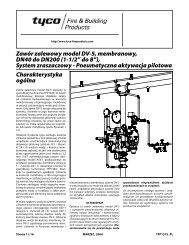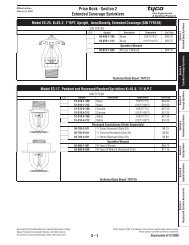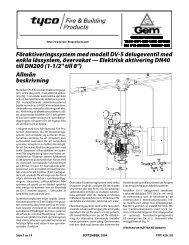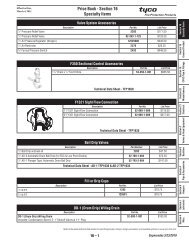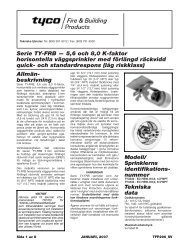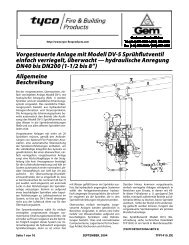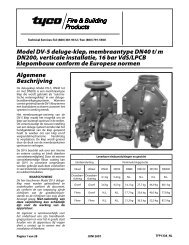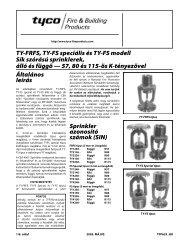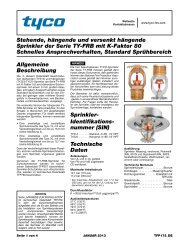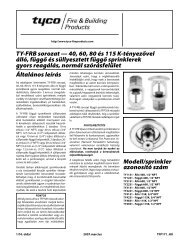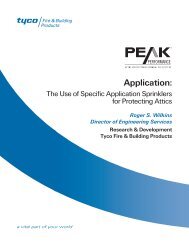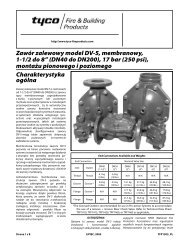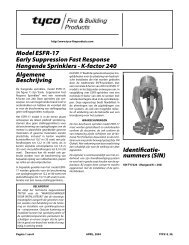Listings and Applications of Residential Sprinklers - Tyco Fire Products
Listings and Applications of Residential Sprinklers - Tyco Fire Products
Listings and Applications of Residential Sprinklers - Tyco Fire Products
You also want an ePaper? Increase the reach of your titles
YUMPU automatically turns print PDFs into web optimized ePapers that Google loves.
FLAT SMOOTH & SLOPED CEILINGS<br />
RESIDENTIAL SPRINKLERS<br />
WHAT HAS THE INDUSTRY DONE?<br />
The fire sprinkler manufacturers have complied with the new industry st<strong>and</strong>ards.<br />
Underst<strong>and</strong>ing these new products, their <strong>Listings</strong>, <strong>and</strong> applications is critical to proper residential<br />
design <strong>and</strong> installations. Most manufacturers have ab<strong>and</strong>oned the use <strong>of</strong> old residential sprinklers<br />
<strong>and</strong> listings in favor <strong>of</strong> optimizing new lines <strong>of</strong> residential sprinklers.<br />
<strong>Tyco</strong> <strong>Fire</strong> <strong>Products</strong> (Central, Gem <strong>and</strong> Star), maintaining a leadership role, has worked with<br />
AHJs, contractors <strong>and</strong> industry association members to identify the most common room sizes,<br />
ceiling configurations, <strong>and</strong> water supplies to develop a line <strong>of</strong> residential sprinklers <strong>and</strong><br />
applications that meet the needs <strong>of</strong> the industry. We have optimized for both flow <strong>and</strong> pressure<br />
based on the most common uses. The following tables <strong>and</strong> figures detail the minimum flows <strong>and</strong><br />
pressures required for TFP’s new line <strong>of</strong> residential sprinklers.<br />
Additionally, a competitive analysis for each application is included in the tables. The flows<br />
<strong>and</strong> pressures for the TFP products are accurate, <strong>and</strong> are as Listed. The competitors’ flows <strong>and</strong><br />
pressures were accumulated from many sources as <strong>of</strong> February 13, 2003 (6 months after<br />
compliance date). Some <strong>of</strong> these may have changed, <strong>and</strong> we make no representation to their<br />
<strong>Listings</strong>. The reader should verify the actual current data with each manufacturer.<br />
FLAT SMOOTH CEILINGS AND SLOPED CEILINGS<br />
Figures 3 through 8 show the flows <strong>and</strong> pressures for flat smooth ceilings in the “Flat” column,<br />
sloped ceilings in the “4/12 Slope” <strong>and</strong> the “8/12 Slope” columns respectively. Sloped ceilings<br />
<strong>Listings</strong> are optional for the manufacturer to obtain. For the reasons stated above in the definition<br />
section, <strong>Tyco</strong> <strong>Fire</strong> <strong>Products</strong> obtained sloped ceiling <strong>Listings</strong> for its entire residential line to relieve<br />
the burden <strong>of</strong> design “equivalent methods” from the contractor <strong>and</strong> AHJ. For flat <strong>and</strong> sloped<br />
ceilings, the most competitive flows available match the minimum .05-gpm/sq ft for the area <strong>of</strong><br />
protection. An example <strong>of</strong> the minimum flow allowed for common spacings <strong>of</strong> 16ft x 16ft (256 sq<br />
ft) is 13 gpm, 18ft x 18ft (324 sq ft) is a minimum <strong>of</strong> 17 gpm <strong>and</strong> 20ft x 20ft (400 sq ft) is 20 gpm.<br />
All <strong>Listings</strong> other than “Flat” are special applications that the manufacturer chooses to have tested<br />
<strong>and</strong> Listed.<br />
Each category <strong>of</strong> Pendent <strong>and</strong> Recessed Pendent, Horizontal Sidewall <strong>and</strong> Recessed Horizontal<br />
Sidewall, Flush Pendent, Flat Plate Concealed, <strong>and</strong> Domed Concealed are shown in Tables 3<br />
through 8 respectively. Again, as <strong>of</strong> February 13th, 2003 the information for all manufactures is<br />
current based on a variety <strong>of</strong> sources such as websites, data sheets <strong>and</strong> UL <strong>Listings</strong>. Verification <strong>of</strong><br />
these flows with each manufacturer is necessary prior to actual design.<br />
[10]



